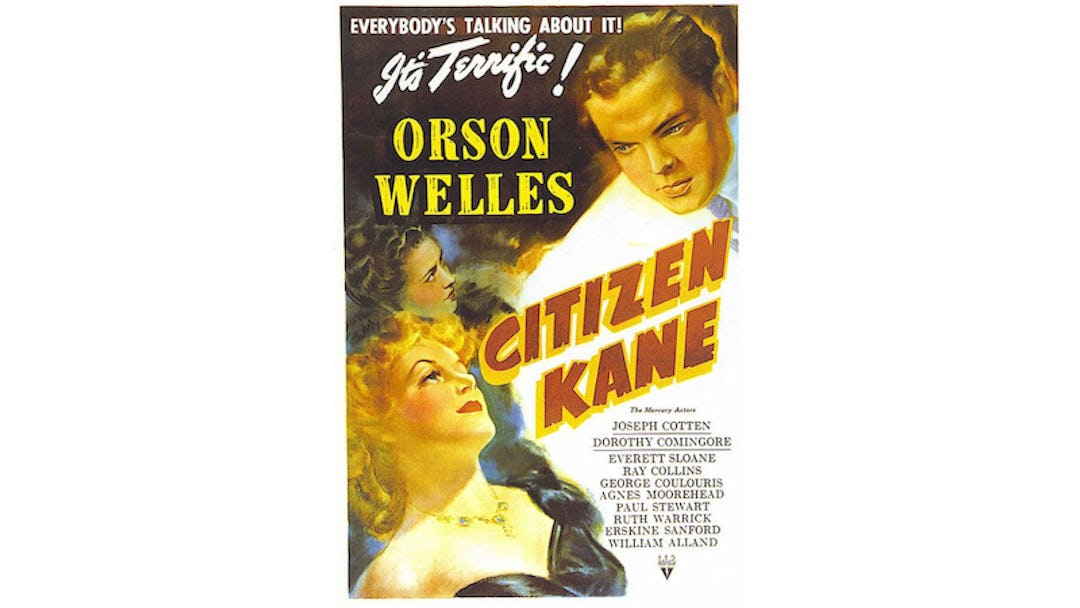The 1941 classic film Citizen Kane, Orson Welles’ first feature, is frequently recognized as one of the greatest movies ever made. The semi-biographical story is about the troubled life and legacy of ruthless publishing magnate Charles Foster Kane (played by Welles). The movie opened 75 years ago today. We look at ten fascinating facts about Welles’ movie, including its pioneering use of visual effects, extensive makeup applications, and why RKO Pictures gave a 24-year-old kid complete artistic control of the film.
In order to play older Charles Foster Kane, Orson Welles sat in the makeup chair from 2:30AM to be ready for a 9AM shoot. He wore custom contact lenses to enhance the look, which blurred his vision. Makeup artist Maurice Seiderman made body casts of the film’s actors to fit them with naturalistic facial applications and body pads for makeup effects that spanned ages 25 to 78.
Production advisor Miriam Geiger created a handmade film textbook for Welles, a reference book of techniques he studied — including those of The Cabinet of Dr. Caligari and films by Frank Capra, René Clair, Fritz Lang, King Vidor, and Jean Renoir. It inspired his shot choices in the film.
Orson Welles grew to resent his own Rosebud twist in the film, calling it, “Dollar-book Freud.”
Breaking with tradition, the film made use of muslin fabric ceilings, which helped to conceal microphones. Camera boxes were built into the floors to capture low-angle shots. Cinematographer Gregg Toland explained:
The Citizen Kane sets have ceilings because we wanted reality, and we felt that it would be easier to believe a room was a room if its ceiling could be seen in the picture. Furthermore, lighting effects in unceilinged rooms generally are not realistic because the illumination comes from unnatural angles. We planned most of our camera setsups to take advantage of the ceilings, in some cases even building the sets so as to permit shooting upward from floor level. None of the sets was rigged for overhead lighting, although occasionally necessary backlighting was arranged by lifting a small section of the ceiling and using a light through the opening. The deep sets called for unusually penetrating lamps, and the twin-arc broadsides mentioned earlier filled the bill. The ceilings gave us another advantage in addition to realism — freedom from worry about microphone shadow, the bugaboo of all sound filmming. We were able to place our mikes above the muslin ceiling, which allowed them to pick up sound but not to throw shadows.
Bernard Herrmann composed the score for the movie, his first film soundtrack. “I worked on the film, reel by reel, as it was being shot and cut. In this way, I had a sense of the picture being built, and of my own music being a part of that building,” he said of his process.
“There was indeed a definite effort to stop the shooting, by those elements in the studio attempting to seize power,” Orson Welles explained in an interview when asked if people tried to stop the movie from being made. He also addresses questions about Kane’s inspiration and whether he was based on real-life newspaper tycoon William Randolph Hearst.
The narration on this special effects clip is a dry, but it gives some good examples of how Citizen Kane pioneered several ways of shooting visual effects — many of them done effectively despite being on the cheap.
Welles was only 24 years old when he started making Citizen Kane, his first feature film. When asked in a 1981 interview how he convinced the studios to give him control of the movie, he stated: “Sheer ignorance. I didn’t want to go to movies all that much, and I kept raising the ante because I was very happy where I was in the theater and the radio. I asked for the impossible. That’s the way to get it in Hollywood.” Welles has also famously remarked that Hollywood essentially gave him “the biggest electric train set any boy ever had” when they allowed him to make the picture.
Citizen Kane was critically acclaimed, but dubbed a box office failure as far as its creators’ expectations, in part because Hearst didn’t allow mention of the movie in his newspapers (the biggest chain in the country). The film lost $160,000 during its initial theatrical run.
Citizen Kane‘s opening title sequence featured a title credit without actors and other crew members listed, which was extremely rare for the time period. The style has been copied ever since.
